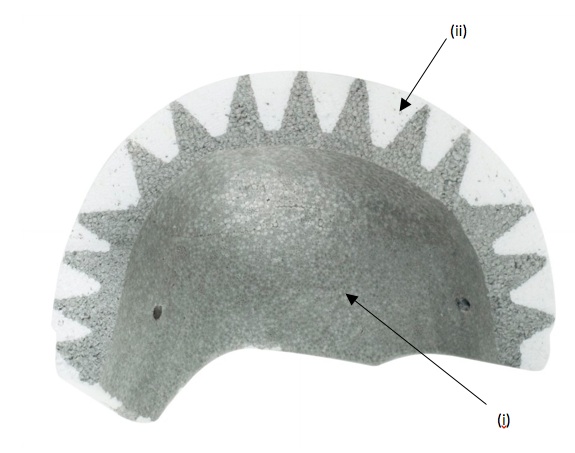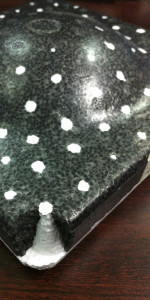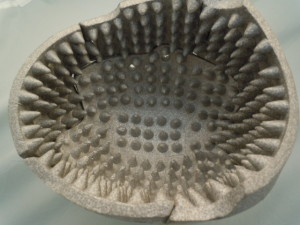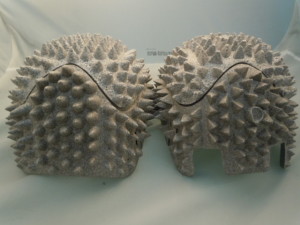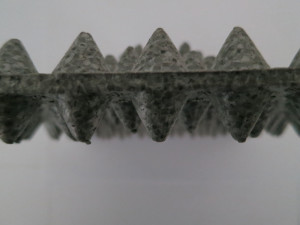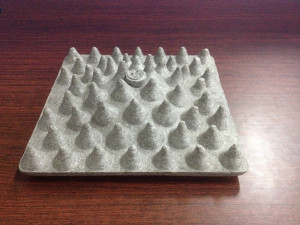Generations of Helmets
The structure:
The ![]() technology liner is a shock absorbing foam liner for safety helmets that incorporates cone-shaped structures within the thickness of the helmet liner.
technology liner is a shock absorbing foam liner for safety helmets that incorporates cone-shaped structures within the thickness of the helmet liner.
The revolutionary shock absorbing ![]() technology liner consists of two layers.
technology liner consists of two layers.
The ![]() layer (i.e., the inner layer) consists of four different regions of cones or triangular based pyramids made of expanded polystyrene foam of varying low densities which is designed to meet the different weaknesses/strengths of the skull.
layer (i.e., the inner layer) consists of four different regions of cones or triangular based pyramids made of expanded polystyrene foam of varying low densities which is designed to meet the different weaknesses/strengths of the skull.
The overlying layer (i.e., the outer layer) is made of expanded polystyrene foam of single density which is of higher density compared to the ![]() layer.
layer.
The generations:
1st Generation – 
Photo 1: Shows a ![]() technology liner = (i)
technology liner = (i) ![]() layer + (ii) overlying layer
layer + (ii) overlying layer

Photo 2: Shows a ![]() layer with cones
layer with cones
Photo 3: Shows a cone exposed in
a test sample of a ![]() technology liner
technology liner
Photo 4: Shows samples of 1st generation
![]() technology liners and
technology liners and ![]() layers
layers
2nd Generation – (i) triangular base pyramids (ii) cones facing inwards
Photo 5: Shows a ![]() layer with triangular based pyramids
layer with triangular based pyramids
Photo 6: Shows a ![]() layer as an outer layer with cones facing inwards.
layer as an outer layer with cones facing inwards.
The inner layer (not shown) is the overlying layer.
Photo 7: Shows the comparison between
1st and 2nd generation ![]() layers
layers
3rd Generation – double 
 Photo 8: Shows a test sample of a double
Photo 8: Shows a test sample of a double ![]() technology liner =
technology liner =
(i) double ![]() layer +
layer +
(ii) overlying layers (inner and outer).
The white dots (iii) are apices of cones
Photo 9: Shows a test sample of a double ![]() layer
layer
4th Generation – Super 
Coming soon
Other Structures Tested – Pencil and Funnel Shaped
Photo 10: Shows a test sample of a pencil shaped ![]() layer
layer
Photo 11: Shows a test sample of a pencil shaped ![]() technology liner = (i) pencil shaped
technology liner = (i) pencil shaped ![]() layer + (ii) overlying layer
layer + (ii) overlying layer
Photo 12: Shows a test sample of a funnel shaped ![]() layer
layer
The Benefits of  technology in more detail
technology in more detail
- Absorb an impact force more effectively:
- directs impact energy sideways away from the brain thereby lowering g-forces to the head
- different foam densities (multi-densities) absorb different levels of impact forces thereby reducing the risk of concussion at low level impacts and more severe head injuries at high level of impacts
- A lighter helmet (lower mass helmet): to reduce rotational acceleration of the head during impact
- Segmentation/zoning: to allow the combinations of high and low density foam to be placed close to the vulnerable areas of the skull (child’s skull and adult skull’s) of different thicknesses and strengths
- Enable the use of thinner liners
“For each different size (i.e., S, M, L, XL) helmet incorporating ![]() technology, manufactured and sold under different brand names, has its own density signature comprising of up to five different densities.”
technology, manufactured and sold under different brand names, has its own density signature comprising of up to five different densities.”
~ Don Morgan
